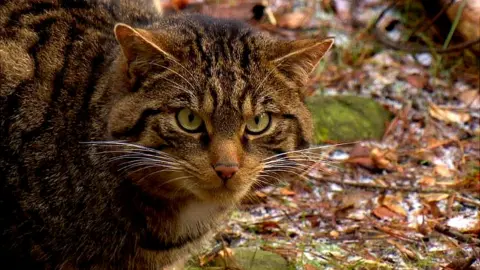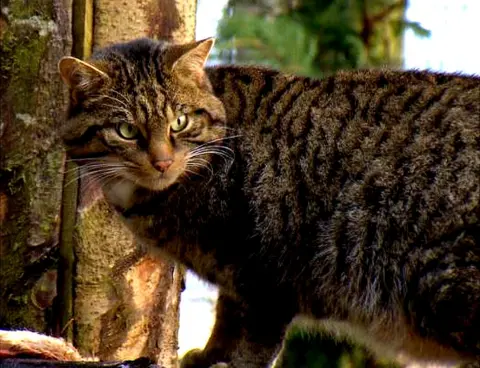Captivity-bred wildcats to be released into wild in Cairngorms
 BBC
BBCCritically-endangered Scottish wildcats bred in captivity are to be released into the wild for the first time.
Funding has been secured for a six-year project to breed and release up to 60 animals beginning in 2022.
Experts have predicted it is "highly likely" the species - known as the Highland tiger - will become extinct without the intervention.
EU funding worth £3.2m has been secured to develop a reintroduction centre in the Highland Wildlife Park at Kincraig.
The cats will be raised away from public view to minimise interaction with humans before their release.
Potential release sites are being explored within the Cairngorms National Park.
The project is being led by the Royal Zoological Society of Scotland which runs the wildlife park.
Helen Senn, head of conservation, said: "Wildcats are on the brink of extinction in Scotland but it's not too late.
"Using wildcats from the existing captive population, as well as cats from Europe to boost the gene pool, the reintroduction centre will provide a sustainable source of wildcats for years to come."
The Scottish wildcat is the only native member of the cat family still found in the wild in Britain.
'Functionally extinct'
For the past few years, conservationists have been focusing on five "priority areas" in Scotland.
Their main defence has been to trap, neuter, vaccinate and release feral cats in those regions to minimise harm to the wildcat populations.
But a study by the International Union for Conservation of Nature declared Scottish wildcats to be "functionally extinct" because of hybridisation with feral or domestic cats.
It examined DNA from hundreds of dead and living wildcats and found they were part of the same hybrid gene pool as domestic cats.
But wildcats have been bred in captivity since the 1970s and they now have a stronger genetic link to their ancestors.
To prevent further hybridisation, Martin Gaywood from Scottish Natural Heritage believes it is important cat owners neuter and vaccinate their pets.
He added: "Releasing species into the wild for conservation purposes is very complex and challenging.
"With the first wildcats expected to be released into the wild in 2022, now is the time for a public discussion on domestic and feral cat populations, and how we manage these, and the public will have an important role in helping minimise future hybridisation."

A breeding team at the wildlife park has managed to double the number of wildcats in captivity in the UK to 120 over the last five years.
Four are on public display at Kincraig with a further nine living in large enclosures out of view to minimise human interaction.
The rest are held in zoos and private collections across the UK.
The project will use existing cats to breed another generation which will be the ones selected for release.
Each will be fitted with a GPS collar which allows their movements to be monitored for about the first year of their lives.